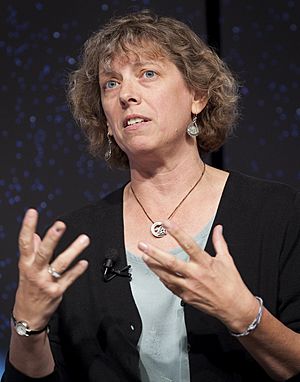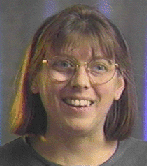Heidi Hammel facts for kids
Quick facts for kids
Heidi B. Hammel
|
|
|---|---|

Hammel speaking at NASA Headquarters in 2009
|
|
| Born | March 14, 1960 |
| Nationality | American |
| Education | University of Hawaii (PhD) Massachusetts Institute of Technology (Bachelor) |
| Awards | Klumpke-Roberts Award (1995) Harold C. Urey Prize (1996) Carl Sagan Medal (2002) |
| Scientific career | |
| Fields | Planetary science Astronomy Geology |
| Institutions | Space Science Institute Massachusetts Institute of Technology |
Heidi B. Hammel (born March 14, 1960) is a famous planetary astronomer. She has spent a lot of time studying the distant planets Neptune and Uranus. In 1989, she was part of the team that took pictures of Neptune using the Voyager 2 spacecraft. Later, in 1994, she led the team that watched Shoemaker-Levy 9's comet hit Jupiter with the Hubble Space Telescope.
Dr. Hammel has used both the Hubble Space Telescope and the Keck Telescope to learn new things about Uranus and Neptune. She found out about dark spots, huge storms, and even new rings around Uranus. In 2002, she was chosen to be a scientist for the James Webb Space Telescope, which is a super powerful new telescope.
Heidi Hammel also spends a lot of time sharing science with everyone. She won the Carl Sagan Medal in 2002. This award is given to scientists who are great at helping people understand planetary science. Discover Magazine named her one of the 50 most important women in science in 2003. She also became an important leader at the Association of Universities for Research in Astronomy (AURA) in 2010.
Contents
About Heidi Hammel's Life
Heidi Hammel was born in California. She is a mother and has three children.
Heidi Hammel's Education Journey
Heidi Hammel went to the Massachusetts Institute of Technology (MIT) and earned her first degree in 1982. She then got her PhD in physics and astronomy from the University of Hawaii in 1988. After working at NASA's Jet Propulsion Laboratory, she returned to MIT. There, she worked for almost nine years as a lead research scientist.
Heidi Hammel's Career in Space Science
Heidi Hammel is now a top leader at the Association of Universities for Research in Astronomy (AURA). This group includes many universities and research places. AURA helps run big observatories like the Hubble Space Telescope and the Gemini Observatory. Dr. Hammel became an executive vice president at AURA in 2010.
She realized that science needs people who plan for the future. She said she wanted to help other young scientists. She wants to make sure they have the chance to explore new things with new tools.
Before joining AURA, Dr. Hammel worked at the Space Science Institute in Boulder, Colorado. In 2002, she was chosen to work on the James Webb Space Telescope. This telescope is even more powerful than Hubble and launched in 2021. She also helped with other important NASA missions and projects.
Heidi Hammel's Research and Discoveries
Dr. Hammel mostly studies the atmospheres and moons of the outer planets. She uses telescopes on Earth and in space. She also uses special technology called Adaptive optics (AO) to get clearer images.
She explains her research by comparing it to Earth's weather. She says that planets like Jupiter or Neptune are made mostly of gas. They don't have oceans or continents like Earth. This makes their weather easier to study. By understanding weather on other planets, we can learn more about weather on Earth.
The Hubble Space Telescope and the Keck Telescope have helped astronomers see Uranus and Neptune much better. They can now capture very clear images and see many details that were hidden before. Dr. Hammel's research shows that Uranus and Neptune are very active planets.
Voyager 2 and Neptune's Secrets
Heidi Hammel focuses on studying the outer planets and their satellites. She was part of the team that used the Voyager 2 spacecraft. This team explored the planet Neptune up close in 1989.
Comet Shoemaker-Levy 9 Hits Jupiter
In 1994, Dr. Hammel led the team that watched a comet named Shoemaker-Levy 9 crash into Jupiter. They used the Hubble Space Telescope to see what happened. Dr. Hammel analyzed the pictures of this amazing event. She also became the public face for NASA, explaining the science to people all over the world on TV.
Neptune's Great Dark Spot
Dr. Hammel was on the team that first saw Neptune's Great Dark Spot. This was a giant storm, as big as Earth! She also led the Hubble Space Telescope team that saw the Great Dark Spot disappear just a few years later, in 1994.
Uranus' Winds and Rings
Since 2000, Heidi Hammel has been studying Uranus with the Keck telescope, along with her colleague Imke de Pater. Dr. Hammel reported the fastest winds ever seen on Uranus. These winds blew at speeds of about 240 to 260 miles per hour in October 2003.
Dr. Hammel also found that Uranus' nine main rings are made of a single layer of particles. This is different from other planet rings. Using the super-sharp optics of the W. M. Keck Observatory, they found an 11th ring around Uranus. This new ring is about 3,500 miles wide. It was visible because it was edge-on to the sun and Earth, reflecting more light. In 2006, they also found that Uranus has a very rare blue ring and a red ring.
As of 2014, her research continued to involve taking pictures of Neptune and Uranus. She used the Hubble Space Telescope, W. M. Keck Observatory, and other telescopes on Earth.
Awards and Sharing Science
Heidi Hammel has won many awards for her research. These include the 1996 Harold C. Urey Prize for planetary science. She has also won awards for sharing science with the public. These include the 1998 Public Understanding of Science Award.
In 2000, she became a Fellow of the American Association for the Advancement of Science. She also received the 2002 Carl Sagan Medal for being an amazing science communicator. The Astronomical Society of the Pacific gave her the 1995 Klumpke-Roberts Award for helping people understand astronomy. She also won the 1996 "Spirit of American Women" National Award for encouraging young women in science.
Discover Magazine recognized Dr. Hammel in 2002 as one of the 50 most important women in science. A book about her, "Beyond Jupiter: The Story of Planetary Astronomer Heidi Hammel," was published.
Dr. Hammel joined The Planetary Society's Board of Directors in 2005. In 2009, she received the Women in Space Science Award.
In 2010, Dr. Hammel took part in the World Science Festival in New York City. She talked about the exciting discoveries expected from the James Webb Space Telescope. This telescope is the most powerful space telescope ever built.
On November 2, 2010, the Association of Universities for Research in Astronomy announced that Dr. Hammel would become their executive vice president. She started this role on January 1, 2011. She said she was excited to help guide the future of astronomy. She wants to give the next generation of scientists new chances to explore the universe.
An asteroid called 3530 Hammel was named after her in 1996.
Heidi Hammel's TV Appearances
- The Planets and Beyond, 2018 TV episode on the Science Channel
- Uranus & Neptune: Rise of the Ice Giants, 2018 TV episode in How the Universe Works, herself as Astronomer
- Hubble's Cosmic Journey, 2015 TV episode on the National Geographic Channel
- Naked Science, 2006–2008 2 TV episodes on the National Geographic Channel
- Hubble's Amazing Universe, 2008 TV episode
- Deadliest Planets, 2006 TV episode, as Dr. Heidi B. Hammel, senior research scientist
- Hubble: Secrets from Space, 1998 TV episode, as Professor Heidi Hammel
Heidi Hammel's Thoughts
"Why do astronomy? Because it can answer the fundamental question, what is the fate of the universe?"
"It made plumes of gases that rose 1,000 miles high. Jupiter was covered with atmospheric soot. If that impact had happened on Earth, we all would have died. It would have created a major disruption of the biosphere. This is what we think happened to the dinosaurs." (About the comet hitting Jupiter in 1994)
"By studying other planets, we learn about Earth, and knowledge of Earth is incredibly important to us as a species." (About studying Uranus and Neptune)
See also
 In Spanish: Heidi Hammel para niños
In Spanish: Heidi Hammel para niños
- List of women in leadership positions on astronomical instrumentation projects


